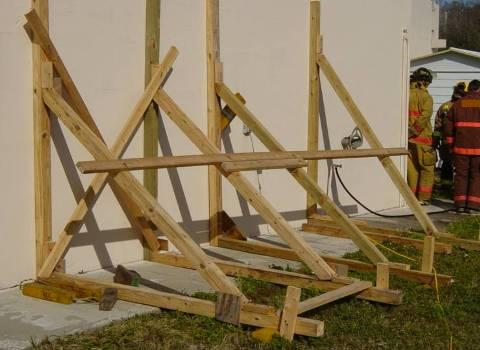
I saw this attempt of a raker shore a number of years ago… I hope they don’t actually plan on ever using this method of shoring. This photo is a prime example of someone who “thinks†they are trained to perform a certain task. Even after being trained, we advocate utilizing the FOG manual when constructing shoring. Each one of the shores is professionally engineered, and needs to be constructed in a very particular manner. As with any other fire service task, on-going training is extremely important. -Jimm-
You perform the way you train!

At first glance, this shoring “appears” to look o.k. But after I took a longer look at it…. I got scared. As much as people think they know how to do something, it never hurts to double check. Good point bringing up the FOG manual. I usually keep a copy in or near my bunker gear. Whether it is raker shores, T-shores, or just plain good information, it always comes in handy. Hopefully someone took a second look at this particular set-up and made the necessary corrections. By the way Jimm, how many nails in a 2′ cleat?
Here is a comment Ponds will appreciate….
This wasn’t in one of those 24 hour shoring courses was it? 🙂
Really, how many problems do you see with this picture?
Where can somebody get the FOGs?
Why, at disasterengineer.org of course.
This is an official FEMA site. Of course a field guide and a hammer do not a shoring specialist make. Get trained by people that know what they are doing and practice your trade.
This is one of my week spots guys. Would you actually tell WHAT is wrong. I’d appreciate it. Thanks
Ray,
The concept is correct which is the “funnel” effect. Collect load from leaning wall, transfer down through the raker, and then to the ground.
So, in a raker, the wall plate has to have 2 foot cleat nailed on it with 14 16D nails in a “5” nail pattern. The photo shows about a 10 to 12 inch cleat. THe same length cleat needs to be on the sole plate (4×4 on ground). The raker is also too short, because the insertion point(raker tip meets wall) needs to be at where the roof or ceiling joist meet the wall studs.
Also, the rakers have to be horzontally braced with 2 x 4 at bottom, middle(dependent on raker length), and top….(They only have at mid point in photo.) After horizontal bracing, then “X” bracing required with 2 x 6 at ends, or no further than 40 feet apart. (Rakers spacing max. 8′ apart).
And, all joints should have 3/4″ plywood gussets (both sides)to secure them.(Nailed with 8d nails). Must also have a curb or large lumber to butt against. Tighten the raker with a set of wedges & voila!, a Solid Sole Raker System.
I’m sure with more training, and using FEMA’s Structural Collapse FOG, Raker Systems can be constructed by most hammer and nail able rescuers!
who cares raker shores r usless anyway
Gentlemen, I have only 1 word. Paratech Rescue Struts.
can anyone post a link to the FOG Manual please.Thanks
RS-
There’s a couple different FOGs available on the FEMA website, but I believe this is the one you’re looking for that includes engineered wood shoring construction:
http://www.fema.gov/pdf/emergency/usr/usr_23_20080205_rog.pdf
There are some other USAR System guides & documents also available here:
http://www.fema.gov/emergency/usr/resources.shtm
On a side note, we pop up temporary shoring at building fires if there’s significant structural damage in an area of the floor or ceiling joists where we need to continue operations (after knockdown, of course). Our ladder company carries 4 prebuilt T-Shores in the top tray under the stick, and has a box of wedges/shims and Ellis clamps & jack available.
Of course we’ve got the Paratech erector set available for bigger jobs, but this has turned out to be a really quick way to make the building safer for final overhaul, removing equipment, and investigation. It’s worked out well for us and I’d recommend others consider spot shoring.
It also serves as a good refresher opportunity so when you do get a car through a building, etc. your skills are fresh.
Be safe Brothers,
Chris
“paratech rescue struts” is three words